Ten days ago I deleted my Facebook account.
A week went by, and it seemed nobody noticed.
So I think I made the right decision.
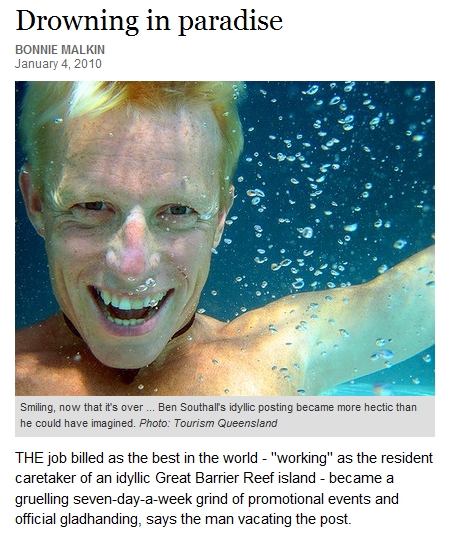
[…screengrab from Sydney Morning Herald, January 4, 2010…]
– – –
…and so it turns out that Ben Southall, who “won” the “best job in the world” (his assignment – to live in the lap of luxury on the islands of Queensland’s Great Barrier Reef while writing a blog about his daily life) had to work a teensy bit harder than he expected.
In this article from the Sydney Morning Herald (via The Telegraph, London) Ben explains how he had to work 19 hour days, in a “gruelling seven-day-a-week grind of promotional events and official gladhanding”. (I love the term “gladhandling”.)
Continue reading
This is a little animation I made a few years back for my sister’s self-published children’s literature magazine Alphabet Soup. It’s a great mag, targeting kids between 5 and 12 years old. Alphabet Soup is based on the philosophy that kids will write better by reading more – and the mag has space for children’s own stories, poems, and drawings too – a virtuous feedback loop…
When we were young, we subscribed to Cricket magazine (from USA) and Puffinalia, a local childrens’ creative writing magazine. These no longer exist, and there are are no equivalents available any more, so in true Ihlein tradition, my sis decided to D.I.Y. She has 3 kids of her own now, so I suppose they are her primary audience – but you can subscribe too!
Coming back to the above animation – we’ve never really done anything particular with it except watch it and chuckle. This little bit of moving image experimentation was the basis for my design of the Alphabet Soup logo, which you can see in flattened, coloured form over on the Soup website (I think it was processed after it left my hands, by my cousin Chris).
More kids lit stuff can be found on Soup Blog too…
[…to follow on from my post about Two Types of Blogs… here is a post related to some of the processes involved in what I, in that post, called “type 2 blogging”…]
Last November, after I attended a permaculture course run by Kirsten and Nick, Kirsten asked me some questions about the nuts and bolts of blogging.
She asked, “In your blogs, how do you find your voice?”
This is an interesting question. What does it even mean, “voice”?
Continue reading
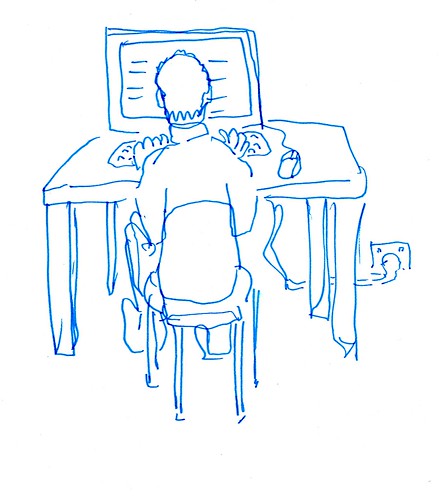
To follow on from my recent post about “good” blogs… I want to get down on blog-paper a few thoughts rattling around my brain about blogging…
Last year my friend Kirsten asked me about blogging – about how to go about making a “good” blog. She, of course, has a good blog of her own, but seeing as I’ve done a couple of very intensive art projects which use blogs as their primary medium, I do have some thoughts about the nuts and bolts of making them work.
Continue reading
It’s probably impossible to answer this question. It’s a bit like asking, “what makes a good book?”
Blogs are so many things to so many people – they are forms of journalism, pedagogical tools for university courses, personal diaries, social hangout spaces, places for writing fan fiction, locations for software to be released and discussed… The list is as long as the uses to which blogs have been put, which is to say, more diverse than I can mention.
Although “early” blog theories (that is, those from about 5 years ago!) emphasised the keeping of journals and diaries as the main function of blogs (Viviane Serfaty’s book is a good example of this notion), the explosion of different uses for blogs has led some more recent definitions to reduce what-blogging-is to bare technological terms – that is, blogging is a medium. This way of defining blogs reduces them to something like this: “Blogs are an online publishing tool; blogs consist of a series of individual “entries”; these entries are usually displayed in reverse chronological order.” (Wikipedia’s definition is along these lines.)
As Jill Walker Rettberg explains in her great little book called, simply, Blogging, within this bare-bones techno-definition of blogging as a medium, various genres can be sifted out: political blogging, filter blogging, diary-style blogging, and so on. Each of these genres (and its attendant sub and sub-sub genres) comes with its own set of conventions, and within the genre, those conventions make sense – they can be used to determine a “good” from a “bad” blog.
In general, though, Walker Rettberg presents three basic criteria which define – not what a blog is, but how it is (p.21). Those criteria are “frequency, brevity, and personality” (she borrows these terms from Evan Williams, the fella who invented Blogger). She then goes on to explain that the first two of these criteria (frequency and brevity) are formal qualities associated with blogs. The third criteria, however, points to a further feature of blogs which is very important, and pertinant, I think, to the question of what makes a good blog – personality. Blogs, she writes are “generally written in the first person”. They are subjective. They are social.
How does this help us think about what makes a good blog? Well, if Rettberg Walker’s last point is true (and I believe it is, wholeheartedly) then the question becomes something like – “what makes a good friend?”
My friends are people that I trust. I trust them, not because they come with some kind of accreditation or references (as I would require if hiring someone for a job). I trust them because of some action they have performed, in relation to me, which makes me believe they are trustworthy.
Perhaps they helped me solve a problem I had. Maybe they told a story about themselves which made me think differently about my own relationship to the world. Or they made me laugh. Or they listened to me when I had something to get off my chest. Whatever the case, hanging out with them was a rewarding experience, regularly enough, for me to say, “I like him/her”. The effort expended in passing time with them was worth it. So I kept coming back, and a relationship between us – friendship – was formed.
And it’s the same for “good” blogs, I would say.
If in doubt, return to blogging! Since the question posed in the title of this blog entry is unfathomable to me, and I am struggling to sort it out in my academic word documents, here I am, back online, where things don’t have to be “right”, just interesting…
Unfortunately, I fear that this question shouldn’t be unfathomable to me, by this stage. I am due to hand in my thesis on 12 June, my scholarship has run out, I’ve been on this boat for over 3 years now… I should, by rights, know WTF “art practice as research” means!
But I don’t.
I’ve always thought of art as a sort of whimsy. It’s something silly to pursue that makes people realise how silly the whole world is, so we might as well relax and not all take ourselves too seriously.
And then, fool that I am, I go and enrol in a PhD programme which proposes that art practice is not only a very serious business, it is a form of RESEARCH that stands up as an equivalent to the research produced by, say, my ole buddy Chris-o, the pharmacologist, who has done an intensive study of withdrawal symptoms of methamphetamine addicts. He will hand his thesis in about the same time as me. Mine will be about blogging as a form of art. Assuming all goes well, we will both end up with PhD degrees. How the hell can they be equivalent?
One of the frustrating things about the job my university requires of me, is that I have to submit an academic research paper. My argument (as best I can muster it) is about how blogging allows knowledge to emerge in a fragmentary, collaborative way. It’s about allowing us to see the process of doing stuff, experiencing life, and turning it over through dialogue, as a thing that is constantly emerging – not a tidy finished product.
And yet, what is the written thesis supposed to be? A watertight product with complete footnotes and all contingencies taken care of. Talk about square peg in round hole, eh?
In various chats with friends who are also trying to shoehorn their unwieldy creative projects into the format for “submission” (think about the meaning underlying that word!), I have mused on other possibilities. How great would it be, I have asked myself, if I could hand in my PhD as a series of blog entries? That way, I could merge means and ends. Method and product would utilise the same system – the thing would actually DO what it said, not just be a way of drily saying something about a process that happens somewhere else.
Here’s how it would work. Each blog entry would have to be relatively concise. Each would pose a question, or state some observations, related to the practice of blogging-as-art (the two projects presented as part of this thesis are Bilateral Kellerberrin and Bilateral Petersham). Just like an academic paper, the entries would refer also to other thinkers and artists, considering ways that others have done this stuff, and suggesting the possible benefits of doing and thinking in the way I have carried out.
But, unlike an academic paper, these entries would then be open to enquiry, suggestion and response from others (and from myself) through the comments form at the end of each blog entry. This would be a strictly ADDITIVE process. Unlike academic writing, blogging creates a sort of knowledge through querying what has been already written, and then responding to the queries, as a dialogical process. (OK, so academic writing does that too, but it’s an interminably long-winded way of doing things, publishing in refereed journals then responding in kind, takes years…).
My point is, the whole process of dialogical exchange (and knowledge production) is laid bare in the blogging format. Furthermore, these blog entries (ie “thesis chapters”) would be published one by one, as they are written. There would thus be the chance that comments and dialogue generated by an early blog entry could affect what happens in the ensuing chapters. The whole process would be emergent – and visibly so – as opposed to the standard academic model of hiding away in the study, burning the midnight oil to get this essay perfect BEFORE making it public. If the academics really required it, I could do a summing-up entry which ran through what I thought I had learned from the process.
All of which is to say, I would like to perform upon academia the same opening-out as I like to perform on the art world. In my way of doing things, art is shown to be a set of emergent processes rather than a magical product that seems to come from some mysterious other planet. Bilateral Kellerberrin and Bilateral Petersham are clear examples of this emergent-process-as-art, where interactions between me and local residents who I bump into, written up on the blog, then lead to further interactions and suggestions for future adventures. My recent goat project Gruffling is this whole method in a nutshell.
Would / could my university accept such a thesis?
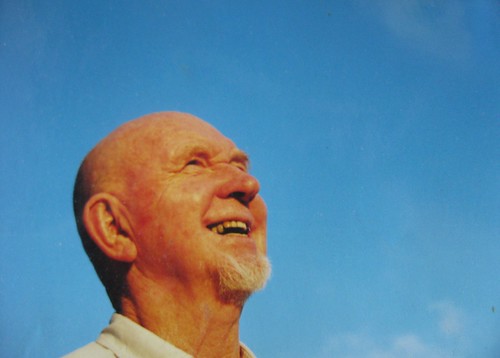
On the weekend I received sad news from Perth, that Arthur Russell has died. He was just shy of his 82nd birthday.
The above photo, taken by Mickie, is from about 8 years ago, when we three visited Kings Park together to check out a memorial sculpture to the volunteer fire brigades by artist Jon Tarry.
Often our adventures with Arthur would involve photography – not just to document the occasion, but also as an act of making compositions. Later, having gotten the photos developed, Arthur would sit with the shots and shuffle through them one by one, comparing the image’s cropping and shapes and tones and colours, and asking anyone in reach to nominate their favourites.
You had to be able to give a reason why, or else you’d get in trouble for a kind of aesthetic cowardice. This was a funny process, because initially you might just choose one of the shots at random as “my favourite” to shut him up, but then, facing the Russell Inquisition for Aesthetic Judgement, you’d have to scratch around your brain and come up with a communicable reason for your choice.
This wasn’t easy, but you’d manage to dredge up something, like “the shapes of the trees anchor the rocks, they almost seem to embrace them” which would then prompt Arthur to scrutinise the photo even more closely. If he could follow what you were saying, he’d laugh out loud and say “Yes! That’s Right!” as if you had shown him something he could never have worked out on his own.
He loved this game. He played it with any pictorial compositions, found or made: his own painstakingly crafted pen and wash drawings, a random photograph from the sports page of the crappy West Australian newspaper, or a cheapo calendar with pictures of horses he’d got on special at the newsagency.
I remember he once told me that he even asked his cleaning guy to help him select the best drawings to be framed for his latest exhibition. Arthur really listened closely to the opinions of others, and you didn’t have to be “qualified” to say something. “Looking”, he believed was a skill everyone had. And Arthur’s skill, I guess, was to get others to look with an increased clarity and intensity.
Arthur was, after all, a teacher. For many years (way before I met him) he taught art at high schools, and also ran the educational programme at the Art Gallery of Western Australia. I met him first, back in 1993, when our teacher Barb Bolt brought him in as a guest lecturer to run a series of life drawing classes. I was only 17.
Here are two things I remember about that class:
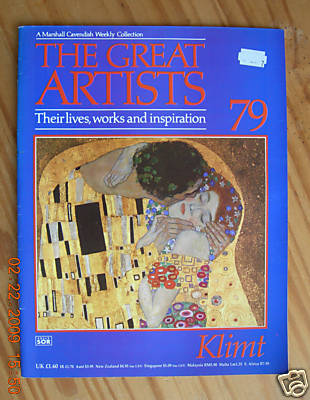 (1). Arthur lugged in a whole bunch of these 1980s periodicals called “the great artists”. (Here’s one I found a picture of, in fact, I’m pretty sure he brought this particular one to class.) He wanted us to give our opinion on which artist made the most interesting drawings of bodies: Leonardo or Klimt or Schiele etc. We had to point to specific things in the drawings as we grappled to express our half-baked preferences. Schiele‘s drawings seemed very tortured and contorted, I remember we students liked that. We thought Klimt was a bit decorative. And so on. The point is, he always validated our thinking: the Russell Inquisition was gruelling and sometimes irritating, but if we got into the spirit of it, he made us feel important and intelligent, like we were coming up with new insights that were fresh and special.
(1). Arthur lugged in a whole bunch of these 1980s periodicals called “the great artists”. (Here’s one I found a picture of, in fact, I’m pretty sure he brought this particular one to class.) He wanted us to give our opinion on which artist made the most interesting drawings of bodies: Leonardo or Klimt or Schiele etc. We had to point to specific things in the drawings as we grappled to express our half-baked preferences. Schiele‘s drawings seemed very tortured and contorted, I remember we students liked that. We thought Klimt was a bit decorative. And so on. The point is, he always validated our thinking: the Russell Inquisition was gruelling and sometimes irritating, but if we got into the spirit of it, he made us feel important and intelligent, like we were coming up with new insights that were fresh and special.
(2). He brought along oranges cut into wedges for “half-time”. We thought this was hilarious. The oranges made the life drawing session seem like a sports game rather than a dreary educational obligation. It was a small gesture, incredibly cheap and easy for him to execute, but it really made us feel like he gave a shit about making our encounter into an event.
Later, Mickie and I became good friends with Arthur outside of the university context. We would visit him at his home in Scarborough, later at Northam, then at the crazy Serbian Retirement Village he wound up in. His house was scrupulously clean, and he had nothing more than what he required: just the right amount of plates and cups and glasses, all carefully chosen for their utility and aesthetic value.
He liked lunches. When assembling lunch, an important job (delegated to the visitor) was to choose which plates to use. Once again, it was important to discuss why you made these crockery choices for this particular food: decoration, form, functionality, food: there was no ordinary lunch with Arthur. But none of his kitchenwares were expensive, usually just accidentally “marvellous” designs that had somehow made their way through to the discount store at the mall.
He was crazy about iced coffee. He developed odd ways, as I suppose happens to people who live on their own. He would make up half a dozen iced coffees at once, and then store them in the fridge, ready to go, in six separate glasses. I’m not joking – one day a few years back I documented the process:
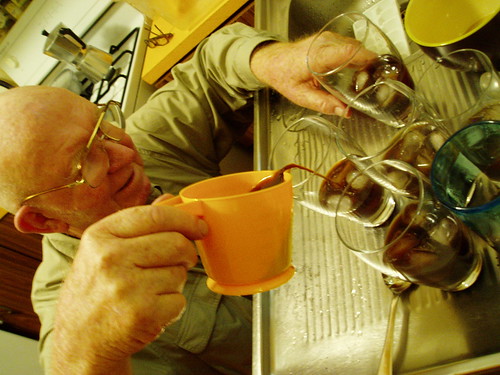
Sharing the huge batch off coffee into six glasses…
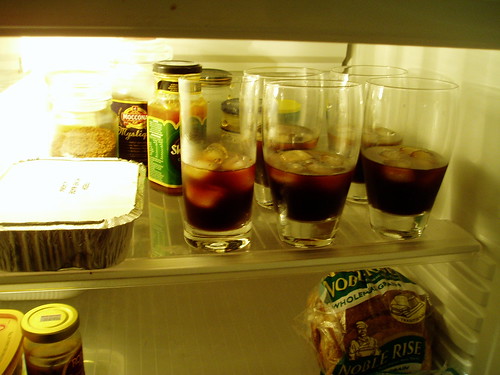
Lining up the glasses in the fridge…
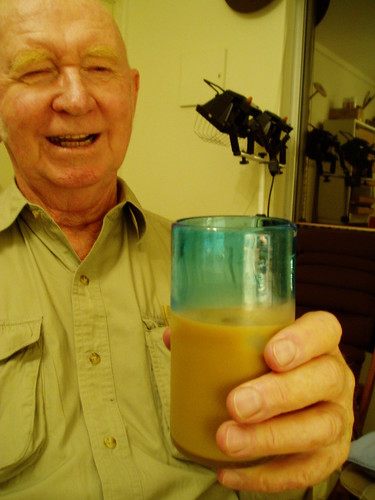
Look at how pleased he is with himself…
When he wanted an iced coffee (which was quite often) Arthur would add cold milk (a 50-50 mix) just before drinking. (I guess this just-in-time milk addition would give him the option of offering his guest a black coffee…)
After you visited him, undoubtedly you’d get a phone call a day or so later to reprise some tiny corner of a topic of conversation you’d already forgotten about. Even if he was a bit cranky sometimes, “Young Arthur” excelled on the phone. He would ring up abruptly to share “a new thought”. Even though these thoughts were often compliments, they were delivered in a very brusque manner, with very no time for pleasantries. The call would go like this:
Me: Hello?
Arthur: Arthur here.
Me: Ah, gday, how’s it going?
Arthur: Two things: first, I think you’re spot on with what you were saying about that [insert name of exhibition or movie here]. I think that was a bloody good insight. Second, your latest project is a real gift to [insert name of institution or community here]. It’s an act of generosity, they’re lucky to have you.
Me: Yeah well I wonder what…
Arthur [interrupting]: Did you hear that? I just paid you a compliment and you moved on and changed the subject without acknowledging it!
Me: Oh. Thanks.
Arthur: You have trouble taking compliments, you know that?
[…this would carry on for a short time… Then, as abruptly as it began, Arthur would decide it was now time to end the call…]
Arthur: Are we right then?
Me: Yep.
Arthur: Righto. Talk soon. Bye.
Me: Bye.
Speaking of phonecalls: Arthur was one of those “old people” who pride themselves on being able to guess who is on the other end of the phone, just by the sound of their voice. So it was pretty alarming to me, last May, when I called him up and said playfully “guess who this is ?” – and he couldn’t guess.
I thought he was joking, but he wasn’t. And his voice had gone all slurry. Oh. God. “Young” Arthur was now old. My eyes were filling up with tears on the phone, I didn’t want him to hear me cry as we talked. Arthur had changed. He struggled to tell me what had happened. They didn’t really know, but he was going into the hospital for some tests. Maybe Parkinsons.
But it wasn’t Parkinsons, the doctors thought it was a series of “mini-strokes” which had rocked his body. I visited him in hospital. He found it easier to communicate in person, still trying to make fun of the nurses and the fluorescent food they served him for lunch (which he tried to fob off on me). His life was already flagging at that point, but he sat up in bed making drawings, getting the orderlies to sharpen his pencils for him.
Here are the drawings he was working on the day I visited:
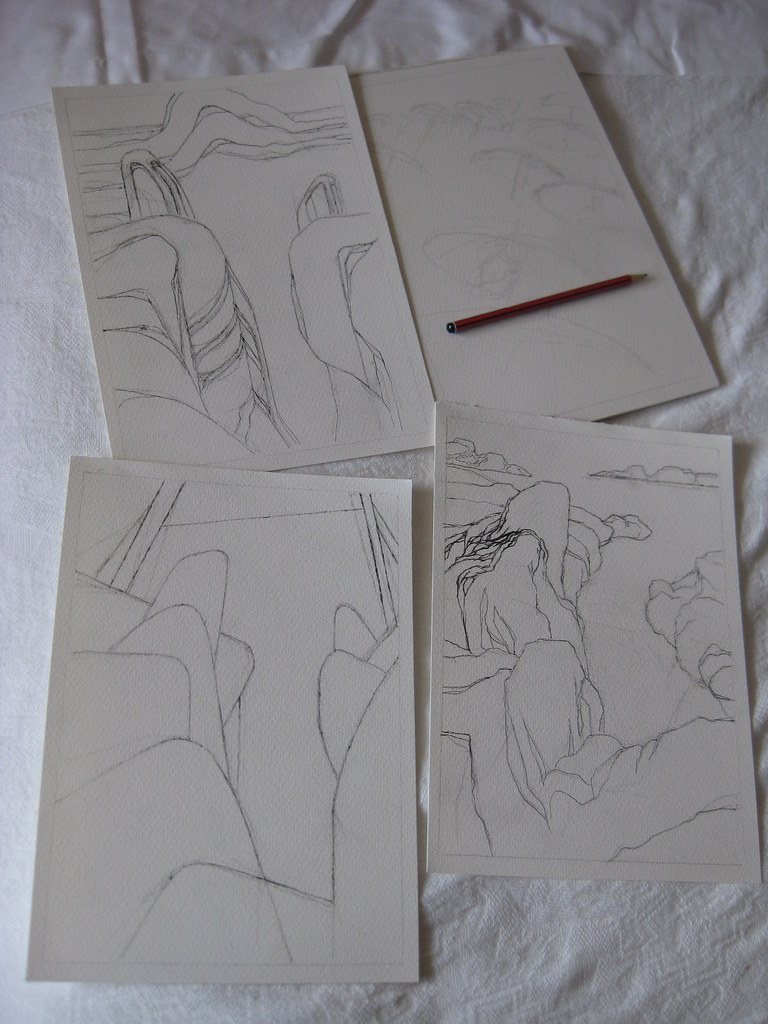
These are the last images I have of Arthur.
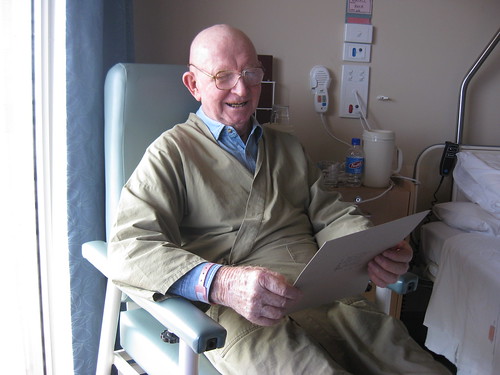
I brought him a copy of a screenprint, the handwritten text of a dream about AC/DC which I made during the Bon Scott project I did last year. It’s a pretty funny dream, with the members of AC/DC sharing a warehouse with the members of a feminist architecture collective. He immediately engaged with it, reading it from start to finish in front of me, in silence, while I sat waiting, watching him, and taking these photos. When he got to the end, he cracked up:
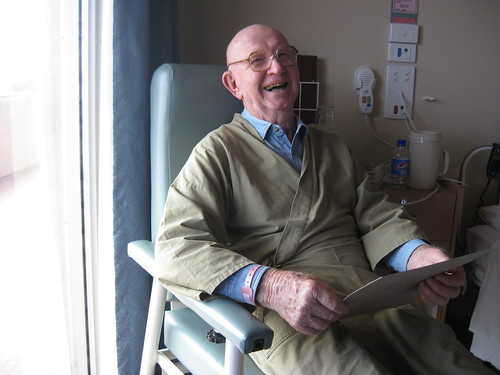
After I returned to Sydney, I sent Arthur a few postcards to keep him updated on what I was up to, especially what I was trying to write about in my thesis. I knew he was not much chop on the phone – there was too much “what?” and “say again?!” from both of us – but I guessed he would enjoy getting the cards. Every time, a few days after I sent a card, he’d call me up. Sometimes we’d talk, but more often, he’d get my answering machine, and leave a long, convoluted and mumbling message I could only half make out. These messages were incredibly sweet, and incredibly sad. His last message was full of praise for me: he said something about how it was really marvellous what I was doing, how my project was generous and intelligent and most importantly, “not at all elitist”. I saved it on my phone, but after seven days the phone company cleared the saved messages and it was gone.
And now, so is he.
Farewell Young Arthur, I loved you old fella.
passing this on from the
Sydney Art Seen Society:
……………………
ECHO ACTION NO. 1
Yo Yo your No No
PUBLIC MEETING please pass on to others
WHEN MONDAY, 26 JULY 2004
WHERE AUSTRALIA COUNCIL (ENTRANCE)
372 Elizabeth Street, Surry Hills
TIME 5:00 to 6:15pm
VISUAL ARTISTS say NO TO NOTHING but YES TO ACKNOWLEDGEMENT
With a Federal election looming, the Sydney Arts Management Advisory
Group (SAMAG) has invited the Federal Minister for the Arts, Shadow
Minister for the Arts and Arts spokespeople from the Australian
Democrats and The Greens to debate arts policy.
They will speak on how they see the future of the arts and what
policies they have to support and enrich the arts industry.
This meeting will be on Monday, 26 July 2004 at the Australia Council.
Please come along and greet the Feds to let them know what matters to
visual artists:
PROPER ACKNOWLEDGEMENT.
Yo yos will be supplied or bring your own.
This, our first echo action, is part of the VISUAL ARTISTS say NO TO
NOTHING national campaign (26 July – 30 August) that will carry the
STARVING VISUAL ARTIST “put the cliche’ to rest“ PETITION to
Canberra.
Please come along and Yo Yo your No No to the Feds and join us for a
cup of thermos coffee. At least come along and sign our petition.*
* A petition will be present that calls for a standard artists’ fee
of no less than $2,000 per individual exhibition and a pro rata payment no
less than $500 for group exhibitions to be adopted by all publicly
funded, visual art institutions, nationally.
FOR MORE INFORMATION PLEASE CONTACT CO-CONVENERS OF THE SYDNEY ART SEEN
SOCIETY
GAIL HASTINGS AND LISA KELLY AT sydneyartseen@yahoo.com.au
Sydney Art Seen Society: meeting no. 1
Thursday, 8 July 2004, 7:30pm
Reginald Murphy Hall, Kings Cross
Gail Hastings and Lisa Kelly organised this meeting to lobby for “a raise” in artists fees for exhibitions in Australian galleries and museums which receive government funding. They have been distributing a petition to that effect. About 40 people were in attendance, at my rough estimate, maybe half of them being artists. The other half were, I reckon, “soft spies†– that is, folks who work at government funded galleries who came along to check out what might happen. It was a rainy night, and Sydney people being who they are, it was probably a pretty good turn out.
There was some contention as to the details of the “demands†in the petition – at least $2000 for solo exhibitions, and at least $500 per artist for group shows. Some artists, like Marg Roberts, reckoned that this amount was just as tokenistic as asking for $50. For Marg, something in the realms of $20,000 was more realistic.
Damien Lawson made a clear comparison between galleries and employers, both of whom have it in their interests to reduce “labour costs†to a minimum. He advocated a more “french†way of organising artist’s wages, something ongoing like a “living wage†and referred to a big artists strike in Paris which ground the big summer arts festivals to a halt. The “living wage” idea (was/is this in place in New Zealand?) also would accomodate the vast majority of artists who DON’T exhibit in government-funded galleries. Lawson’s points were important, I thought, because no matter what the nuts and bolts are of the “demands,†it will be essential for artists to have some kind of solidarity and collectivity in order for it to succeed. Artists seem to always suffer from this idea that we are “individuals” – not to mention the very opportunistic and competitive nature of the contemporary art world.
Chryssy Tintner from Viscopy was there, and she was good to have at the meeting because she pointed out the discrepancy between what is standard procedure in the paying of royalties for the use of music in commercials, for example, and the amount paid for the reproduction of artworks. It’s all part of the same set of rights that visual artists don’t have…
Tamara Winikoff from NAVA was there too – she provided essential information about the ongoing campaigns that NAVA has been involved in to try to improve artists rights – it will definitely be necessary to continue to collaborate with NAVA.
One of the issues that was glaringly obvious was the rarity of this kind of meeting – that artists are not very good at working collectively – and it would be good to get more information about the history and activities of the ArtWorkers Union – it may be necessary to revive the union to become once again a workable grassroots organisation.
A follow up meeting will take place at 2:00pm on Saturday, 17.07.2004 at the Art Gallery of New South Wales coffee shop.
For more information and the full minutes of the meetings, email sydneyartseensociety@yahoo.com
…………………………………………………………………….
ps the original call out for this meeting was:
SYDNEY ART SEEN SOCIETY: meeting no.1
WHOA! Was that a banana skin I just slipped on! or just another sliding
art-institution standard?
URGENT PUBLIC MEETING please pass on to others
WHEN THURSDAY, 8 JULY 2004
WHERE REGINALD MURPHY HALL
Corner of Greenknowe Ave and Elizabeth Bay Rd, Kings Cross
TIME 7:30 to 8:45pm
The Sydney Biennale opened recently, which provided the opportunity for
many artists to meet and a number to recognise in each others misfortunes
the rapidly declining viability of the local, visual art situation here.
While the Howard Government may have commissioned the Myer Report to analyse,
nationally, the extent of artists’ troubles, its recommendations have not
only not at all been felt within the visual arts at the ground level (ie. by
artists), but also little address the pervading ‘dumbness’ (in both senses
of lacking intelligence and a stifled dialogue (lacking speech)) that is
creeping through our major art institutions and throttling an engaging and
internationally recognisable contemporary visual culture here. Sydney is
quickly becoming the black hole of the Australian contemporary art scene,
the place where contemporary visual artists get swallowed up and disappear:
their work unacknowledged, its potential wasted. Need this be so?
If you feel like some dangerous discussion, please join us at this informal
meeting to rekindle a much needed dialogue and to work out ways to kick-start
a re-engaged, contemporary visual culture in Sydney. At least
come along and sign our petition.*
* A petition will be present that calls for a standard artists’ fee of no
less than $2,000 per individual exhibition and a pro rata payment no less
than $500 for group exhibitions to be adopted by all publicly funded, visual
art institutions, nationally.
FOR MORE INFORMATION PLEASE CONTACT CO-CONVENERS GAIL HASTINGS AND LISA
KELLY AT sydneyartseensociety@yahoo.com
The Sydney Art Seen Society has been formed as an urgent redress of the
current decline of standards in the professional environment of contemporary
visual art in Sydney, where the production of visual culture is being more
and more determined by art-institutional programmes rather than these
programmes being determined by the art. By facilitating a meeting place for
artists to discuss, debate and discern solutions to the prevalent issues
hindering progressive visual art here at present, the Sydney Art Seen
Society aims to stimulate the development of a more vigourous and potent
contemporary visual culture in Sydney, based on the vital and critical
practice of visual artists.
DUE TO THE IMPOVERISHED STATE THE CURRENT SITUATION FINDS VISUAL ARTISTS,
MEMBERSHIP IS FREE, ONE NEED ONLY JOIN AT A MEETING